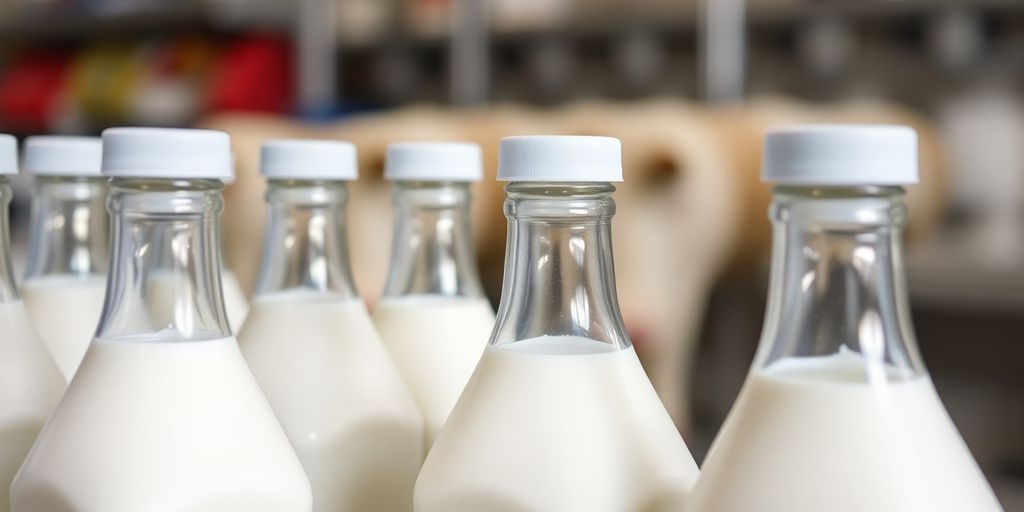The recent decision by the US FDA to halt milk quality tests due to staff reductions has raised serious concerns among consumers and industry experts alike. With fewer employees dedicated to ensuring the safety of milk products, many are left wondering what this means for the quality of milk they consume daily. This article explores the implications of this pause in testing, the reasons behind the cuts, and how consumers are reacting to these developments.
Key Takeaways
- The pause in milk quality testing could lead to more contaminated milk products entering the market.
- Consumer trust in the FDA may decline as fears about milk safety grow.
- Long-term public health risks may arise if milk quality testing remains insufficient.
- State agencies and third-party testing may become more important for ensuring milk safety.
- Advancements in testing technology could help improve milk quality checks in the future.
Impact On Milk Safety Standards
Potential Increase In Contaminated Products
With the FDA pausing some milk quality tests due to employee cuts, it’s pretty obvious that there’s a higher chance of contaminated milk making its way to store shelves. I mean, fewer tests mean fewer opportunities to catch problems before they affect consumers. Think about it: things like bacteria, antibiotics, or even just plain old spoilage could slip through the cracks more easily. It’s not a guarantee that every carton will be bad, but the risk definitely goes up. It’s a bit unsettling, to be honest.
Consumer Trust In Regulatory Bodies
When the FDA, which is supposed to be the watchdog for our food safety, starts cutting back on testing, it erodes public trust. People rely on these agencies to make sure what they’re buying is safe, and when that confidence is shaken, it can lead to a lot of anxiety. It makes you wonder what else is being overlooked. It’s not just about milk; it’s about the whole system. People might start questioning the safety of other products too. This could lead to calls for increased transparency in food safety practices.
Long-Term Effects On Public Health
If contaminated milk becomes more common, we could see some serious long-term effects on public health. Things like foodborne illnesses could become more frequent, especially among vulnerable populations like children, the elderly, and people with weakened immune systems. And it’s not just about immediate sickness; exposure to certain contaminants over time could lead to chronic health problems. It’s a scary thought that a simple glass of milk could pose a risk. We need to consider the potential ripple effects of these cuts on the overall health of the nation.
Reasons Behind Employee Cuts
Budget Constraints Within The FDA
It seems like the FDA, like many government agencies, is facing some serious money problems. These budget limitations are a big reason why they’ve had to cut back on staff, which then affects things like milk quality testing. It’s a domino effect. When the budget gets smaller, they have to make tough choices about where to spend the money, and sometimes, that means reducing the number of people on the payroll. It’s not ideal, but it’s often what happens when funds are tight. It’s a bit like when you have less money for groceries; you have to decide what you can live without.
Shifts In Regulatory Priorities
Sometimes, it’s not just about the money. The FDA might also be changing what they focus on. Maybe they’re putting more effort into other areas of food safety or drug regulation, and that means some things, like milk testing, get less attention. It’s like when a company decides to focus on a new product line and shifts resources away from older ones. Priorities change, and that can have a real impact on different parts of the agency. It’s not necessarily that milk quality is less important, but other things might be seen as more urgent or pressing at the moment. It’s a constant balancing act.
Impact Of Recent Legislation
New laws can also play a role in these employee cuts. If Congress passes a law that changes how the FDA operates or funds certain programs, it can force the agency to make adjustments. Maybe a new law requires the FDA to focus on something different, or maybe it reduces the amount of money the agency has to work with. Either way, these changes can lead to staff reductions and changes in how things are done. It’s like when a new tax law comes out and you have to adjust your budget accordingly. Legislation can have a ripple effect throughout the entire agency, and it’s something they have to deal with.
Consumer Reactions To The Pause
Concerns Over Milk Quality
Okay, so the FDA is pausing milk quality tests? Yeah, people are worried. I mean, who wouldn’t be? It’s milk! We give it to our kids. We put it in our coffee. The thought that something might be wrong with it is unsettling. People are starting to question if the milk they’re buying is actually safe, and that’s a pretty big deal. It’s not like we can just see if milk is contaminated. The FDA suspension makes you wonder what kind of corners are being cut.
Calls For Increased Transparency
One thing I’ve noticed is that people are really pushing for more information. No one likes being kept in the dark, especially when it comes to food safety. We want to know why this is happening, how it will affect us, and what is being done to make sure our milk is still okay. It’s not enough to just say, “Trust us.” People want to see the data. They want to understand the process. They want to know that someone is actually looking out for them. The lack of transparency is fueling a lot of the anxiety around this whole situation. Here’s what people are asking for:
- Detailed reports on past milk quality tests.
- Explanations of the alternative quality assurance measures.
- Regular updates on the status of the FDA’s testing program.
Public Outcry On Social Media
Of course, social media is blowing up. You can’t have something like this happen without everyone weighing in online. There are petitions, hashtags, and endless threads of people sharing their concerns. Some are sharing articles, others are posting memes, and some are even threatening to boycott milk altogether. It’s a mixed bag, but the overall sentiment is definitely negative. People are using these platforms to voice their frustration and demand action. It’s a way for them to feel like they’re doing something, even if it’s just complaining online.
Alternatives For Quality Assurance
With the FDA scaling back its milk quality testing, it’s natural to wonder who’s picking up the slack. It’s not like we can just hope for the best when it comes to something as basic as milk safety, right?
Role Of State Agencies
State agencies already play a big role in milk safety. Many states have their own testing programs that might become even more important now. They often conduct inspections of dairy farms and processing plants, and they test milk samples for bacteria, antibiotics, and other contaminants. It’s possible that these agencies will need more funding or resources to handle the increased responsibility.
Importance Of Third-Party Testing
Independent labs can step in to fill the void. These labs can test milk samples for a variety of things, and their results can give consumers and producers extra assurance. Some dairy companies already use third-party testing to verify the quality of their products. Maybe we’ll see more of that now. It’s worth noting that third-party testing isn’t always cheap, and it’s up to consumers to decide if the extra cost is worth the peace of mind.
Consumer Education On Milk Safety
Ultimately, consumers need to be informed. Knowing what to look for – like sell-by dates, proper storage, and signs of spoilage – can make a big difference. There are resources available online and through consumer advocacy groups that can help people understand the risks and make informed choices. It’s not a perfect solution, but being aware is always a good start.
Future Of Milk Quality Testing
Expected Changes In FDA Policies
Okay, so with the FDA scaling back on milk quality tests, what’s next? It’s hard to say for sure, but I think we can expect some shifts. The FDA might try to focus on the riskiest areas, like large-scale dairy farms or products with a history of problems. They could also push for more self-regulation within the dairy industry. It’s all a bit up in the air, but change is definitely coming.
Advancements In Testing Technology
On a brighter note, testing tech is always getting better. We’re talking about faster, more accurate ways to spot contaminants. Think of it like this:
- Faster Results: Tests that used to take days could soon take hours.
- More Sensitive Detection: New tech can find even tiny amounts of bad stuff.
- Portable Testing: Imagine testers being able to check milk quality right on the farm.
These advancements could help make up for the FDA’s cutbacks, but it all depends on how quickly and widely they’re adopted.
Potential For Increased Funding
Here’s the big question: will the FDA get more money for milk quality testing down the road? It’s possible, especially if there are some major milk-related health scares. Public pressure can make a difference. If enough people complain, Congress might decide to open up the purse strings. But, honestly, government funding is always a gamble. It could go either way.
Broader Implications For Food Safety
If the FDA scales back on milk testing, it makes you wonder what else could be affected. It’s not just about milk; it’s about the whole food system. What happens with milk could easily happen with other foods, and that’s a bit scary.
Effects On Other Food Products
If the FDA is cutting back on milk inspections, it begs the question: what other food products might see similar reductions in oversight? It’s possible that other staples like eggs, produce, or even processed foods could face less scrutiny. This could lead to a higher risk of contamination or mislabeling across the board. It’s a slippery slope, and consumers need to be aware of the potential ripple effects.
Impact On Small Dairy Farmers
Small dairy farmers might feel this change more than the big guys. They often don’t have the resources for fancy in-house testing. If the FDA isn’t checking as often, it puts these farmers in a tough spot. They could struggle to prove their milk is safe, even if it is. This could hurt their business and make it harder for them to compete.
Consumer Awareness And Advocacy
It’s more important than ever for people to know what’s going on with our food. We need to understand where our food comes from and how it’s tested. If the FDA is pulling back, we need to push for more transparency. That means asking questions, supporting companies that prioritize safety, and maybe even getting involved in food policy. Consumer awareness is key to maintaining food safety standards.
Final Thoughts
In the end, the FDA’s decision to pause milk quality tests is a big deal for everyone who drinks milk. With fewer workers, it’s hard to keep up with checking if our milk is safe and good to drink. This could mean more risks for consumers, and that’s not something we want to think about. It’s important for us to stay informed and maybe even push for better support for these tests. After all, we all want to know that what we’re pouring into our cereal is safe and healthy.
Frequently Asked Questions
What does the FDA’s pause in milk testing mean for safety?
The pause could lead to more unsafe milk products reaching stores, which might put consumers at risk.
Why did the FDA cut employee positions?
The FDA is facing budget cuts and has shifted its focus on what to regulate, which has affected staffing.
How are consumers reacting to this news?
Many people are worried about the quality of milk and are asking for more information from the FDA.
What can consumers do to ensure milk quality?
Consumers can look for state inspections, choose brands that are tested by third parties, and learn more about milk safety.
Will the FDA change its policies in the future?
There may be changes coming, especially if public concern grows and more funding becomes available.
How does this issue affect food safety overall?
This situation could impact other foods as well, especially small dairy farmers and may raise awareness among consumers.




